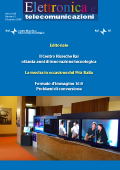 |
Cover |
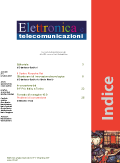 |
Contents |
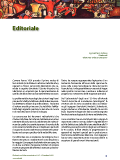 |
G.F. Barbieri
Editorial |
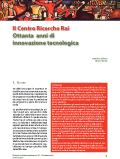 |
The Research Centre - Eigthy Years of Technological Innovation
by
G.F. Barbieri nd A. Morello
The technological innovation activities carried out by Rai has deep roots. The first experiments of Italian television transmission takes place in 1929, first in Milan and then in Turin, where a group of technical EIAR enigineers finalizes the first set-up for shooting and reproducing images, similar to the experiments of transmission of images made in those yearsin UK by John Logie Baird.
The premises where experiments are carried out are those of the historic "Laboratory" in Via Arsenale 21, and those engineers constitute the first nucleus of what later become the "RAI Research Laboratory" and finally "the Centre for Research and Technological Innovation of Rai.
Since then the evolution of Broadcasting has been steady, slow and gradual in the early stages, more and more rapid in recent years, when the convergence of technologies has broken down the historical boundaries between Broadcasting and Telecommunications.
Rai Rresearch Centre has not missed any appointments with this evolution and has been actively involved with proposals and experimental tests in all the major milestones that have marked the path to modern broadcasting, from color TV to TV and digital radio, through the satellite, fiber optics, information tehcnology. Its engineers have achieved major international awards.
Summarize eighty years of the Centre activities of is not a simple task. This article attempts to outline those that were the most significant stages of its history, highlighting its aim and choices of industrial strategy.
|
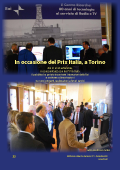 |
In the occasion of The 61th Prix Italy, Turin, September 21st to 26th,
the public had the opportunity to meet researchers RAI
and attend demonstrations on new projects, achievements and future services
|
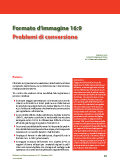 |
16:9 Image Format - Conversion Issues
by M. Visca
The ratio of 4:3 has been in use since the 50's, the birth of television, and still is commonly used for the production and broadcast on all Rai Channels, and nearly the entire archive material is based on this format. Until a few years ago, the home receivers consisted almost entirely of 4:3 TV sets, and this fact has prevented the adoption of the 16:9 format: the wide-screen production has always been very limited, too. This situation has changed with the gradual penetration of flat panel displays, largely in 16:9 format, and with the introduction of the DTT platform. The coexistence of signals and displays with different aspect ratios generates a large series of situations where it is necessary to convert a signal from the ratio of 4:3 to 16:9, or vice versa. The article describes the various ways in which 4:3 and 16:9 formats are displayed, we analyze in brief the concept of protected shooting and summarize the criteria for compliance with the Safe Areas. |